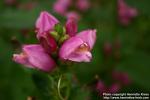You'll find a list of all my blog posts in the blog archive.
Chelone.
So all the books talk about white turtlehead ...
... balmony (Chelone glabra), that is. What a pity I have red turtlehead (Chelone obliqua) in my garden then, eh?
Have a look at purple balmony:
 Pic: The red turtlehead flower lives up to its name. Scary, no? Or perhaps pretty. Or both. I particularly like the way the flower bud turns its nose up at the camera.
Pic: The red turtlehead flower lives up to its name. Scary, no? Or perhaps pretty. Or both. I particularly like the way the flower bud turns its nose up at the camera.
Back to the glabra/obliqua thing: in this particular case the species doesn't matter. These two used to be the same species, back when the eclectics talked about balmony.
A recent discussion on the herblist talked of balmony as being extremely bitter; perhaps it's the way these plants have been growing (in a shady spot), but I don't find the leaf all that bitter. Interesting taste, yes, but not bitter. Say "intensely bitter" and I think hops cones, or dandelion leaf, or spring-dug dandelion root, or even berberis. This doesn't come close.
The plants have been growing in my garden for a few years, spreading slowly but surely, and I picked a large bunch of flower stalks day before yesterday. A neighbor exclaimed: "how pretty!", and her face fell after I told her that I'd dry these and make them into tea. But that's what a herbalist's garden herbs are for, eh? Of course, I don't usually cut everything (bar a few stray stalks), but these will have to be dug up and moved shortly, and it's better for the plant if they don't have to support a large mass of leaf + flowers with their newly truncated roots.
I'm growing balmony as an alternative to the other liver heaters. Michael Moore mentions it in his herbal energetics booklet, page 31, "liver deficiency: metabolic/biliary stimulant", along with berberis, mahonia and linaria, plus some plants which I can't use or find over here.
The eclectics think of balmony as a digestive and liver tonic and/or stimulant; they're pretty verbose about it, so go have a read of King's and Cook for starters, then run through the rest of the list found below the photos on the Chelone glabra page.
Sayre also mentions that it's been used externally for skin troubles. Which more often than not are linked to liver troubles, so that little tidbit fits the liver remedy picture neatly.
Balmony is a nice plant, and it's easy to grow, too. I'll be letting it spread, so I can use more of it. And because I like the purple tops in autumn, when nothing much flowers anymore.


Comments
Chelone glabra is definitely
Chelone glabra is definitely bitter, but ooh! Your red one is pur-ty... If you "open the turtles mouth", you find it looks as if (s)he's recently eaten something; and the structure of it is really quite cool. I imagine its a signature for something, but haven't had any epiphanies ye... ooh! until right now!
It could be a nice signature for sluggish digestion; the foods been eaten, but its not movin anywhere.
Cook extols Turtlehead (which he calls Balmony)as being excellent for constipation from deficient/sluggish digestion. If you go to Micheal Moore's website (www.swsbm.com) and scroll down to the MP3's he's odffering, chelone glabra is one of the samples available to preview.
Chelone
I love Chelone! I would describe it as a "perfect" or "true" bitter. Sharp and clean and leaves the mouth watering. This is as opposed to something like Oregon grape, which certainly is bitter but also "acrid". I personally see "bitter" and "acrid" as subtly distinct flavors.
Thanks for that, Rudy!
Thanks for that, Rudy!